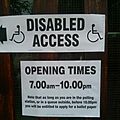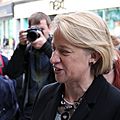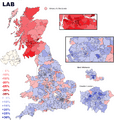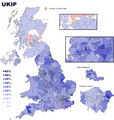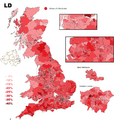United Kingdom general election, 2015 facts for kids
The United Kingdom general election of 2015 was a big event where people across the UK voted for who they wanted to represent them in the government. It happened on 7 May 2015. This election chose the 56th group of people to be part of the Parliament of the United Kingdom.
In the UK, a general election is when everyone who is old enough gets to vote for a person to represent their local area. This person is called a Member of Parliament (MP). All the MPs together form the House of Commons, which is the main part of the UK Parliament.
After the votes were counted, the three main political parties that won the most seats were the Conservatives, the Labour Party, and the Scottish National Party. The Conservative Party won enough seats to form the government all by themselves.
People voted in 650 different areas, called constituencies, across the United Kingdom. Each area elected one MP. On the same day, many local elections also took place in England, but not in Greater London.
Contents
Election Results: Who Won Seats?
This section shows how many MPs each political party had elected in the 2015 general election.
- 330 Conservative Party MPs were elected (this was 28 more than before).
- 232 Labour Party MPs were elected (this was 24 fewer than before).
- 8 Liberal Democrat MPs were elected (this was a big drop of 48 seats).
- 56 Scottish National Party MPs were elected (this was a big gain of 50 seats).
- 8 Democratic Unionist Party MPs were elected (up 1).
- 4 Sinn Féin MPs were elected (down 1).
- 3 Plaid Cymru MPs were elected (no change).
- 2 Ulster Unionist MPs were elected (up 2).
- 3 Social Democratic & Labour Party MPs were elected (no change).
- 1 UK Independence Party MP was elected (down 1).
- 1 Green Party of England and Wales MP was elected (no change).
- 1 independent MP was elected (this means they don't belong to a political party).
Also, John Bercow, who was the Speaker of the House of Commons (a special role that doesn't belong to a political party), was re-elected.
After the Election: New Government and Leaders
After the election, the Conservative Party had 330 seats. This was enough for them to form a government on their own, without needing to team up with another party. David Cameron continued to be the Prime Minister.
Because their parties didn't do as well as they hoped, several party leaders resigned. Ed Miliband stepped down as the leader of the Labour Party, Nick Clegg resigned as the leader of the Liberal Democrats, and Nigel Farage resigned as the leader of the UK Independence Party (UKIP). Jim Murphy also resigned as the leader of Scottish Labour.
Images for kids
-
Ed Miliband, leader of the Labour Party.
-
David Cameron, leader of the Conservative Party.
-
Nick Clegg, leader of the Liberal Democrats.
-
The Conservative Prime Minister David Cameron stood for a second-term in office.
-
Ed Miliband was leader of the opposition and leader of the Labour Party after winning a leadership election against his brother David Miliband.
-
Nick Clegg and the Liberal Democrats showed a great fall in the polls after entering a coalition government with the Conservatives.
-
UK Independence Party leader Nigel Farage stood in the South Thanet constituency.
-
Nicola Sturgeon is the fifth First Minister of Scotland and the leader of the Scottish National Party, in office since 2014. She is the first woman to hold either position.
-
Natalie Bennett, leader of the Green Party of England and Wales. She contested in Holborn and St Pancras.
See also
 In Spanish: Elecciones generales del Reino Unido de 2015 para niños
In Spanish: Elecciones generales del Reino Unido de 2015 para niños








